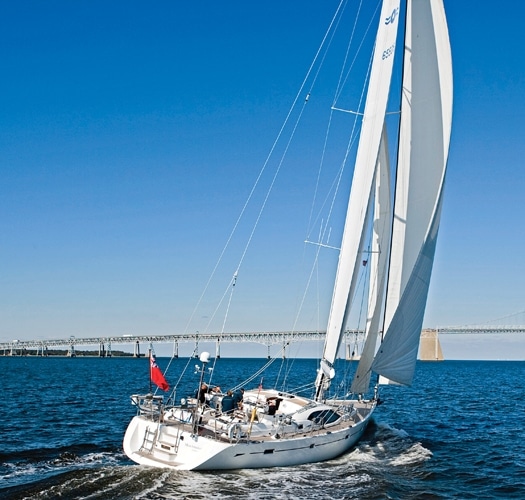
ytgjan26ryb525.jpg
I meet every new day on the water with great anticipation and this day was no different. For my scheduled sail aboard Oyster’s new 655, the weather was perfect, with the wind blowing in at 13 to 16 knots on a clear fall afternoon on Chesapeake Bay. I decided to share the day with a friend to get his take on the boat. Adding to my anticipation was the simple fact that I rarely write boat reviews. You see, I understand that potential buyers take reviews seriously-and so do I. A boat such as the 655 that costs over $3 million is a major commitment for any yachtsman. I am not a boat surveyor, or naval architect, just a sailor with a lot of racing and cruising miles under my keel.
One of the first things I noticed about the Oyster 655 is that this is a big boat. Her LOA of 67 feet, 7 inches and beam of 18 feet, 5 inches easily accommodated the five of us for our test sail. “Five is a really comfortable number for a long passage,” said the Peter Lloyd, the British owner of Matchmaker, our test 655. “We crossed the Atlantic last year with five on board.” (Thanks to the equipment, short-handed sailing is not out of the question, however.) The mainsail is rolled into a carbon fiber mast and electric winches make handling the sails an easy assignment. Matchmaker was designed with cruisers in mind, but Oyster also offers a high performance version for owners looking to be more competitive around the buoys.
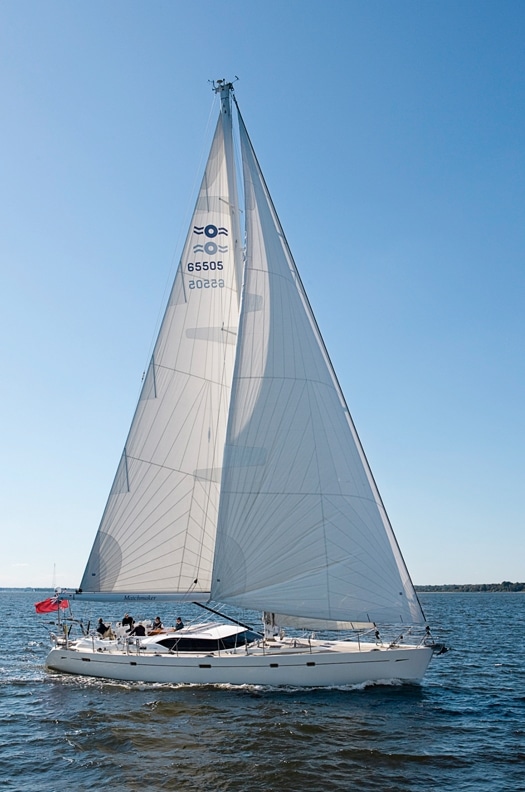
| | |
During our afternoon sail, I was able to explore every part of the boat. As I made the rounds, I quickly realized that the 655 is a very strong hull. There was no groaning or creaking. Everything is solid, which should negate any hesitation in heading off on ambitious long distance passages.
I spent two weeks on an Oyster 62 in 2005, sailing around the Svalbard region at 80 degrees north. The boat performed extremely well in a harsh environment and the 655 would be ideal for such an expedition, as well. An enduring design feature on Oyster yachts is a raised house with large windows. Enjoying the view is one reason why arriving at a destination is more than half the fun. Down below there are several ports that are strategically placed for good viewing both at anchor and during passage. One of my favorite ports is in the U-shaped galley, which offers the cook a view and a secure area while sailing. Nice touches were the custom mug locker, top-loading freezer, and front-opening refrigerator. Dish duty is improved with a double stainless sink with drainage grooves leading from the counters. During our sail, the waves on the Bay were choppy, but I felt very stable and secure below-this is an especially key design element in a galley.
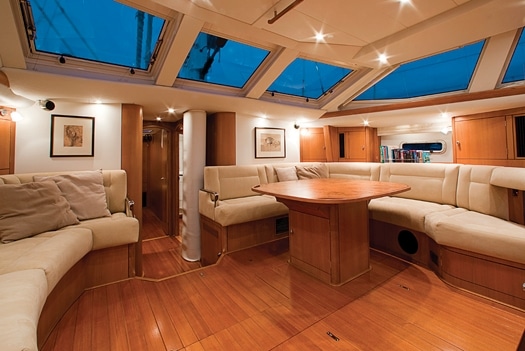
| | |
The interior featured light maple wood paneling throughout, but Oyster offers several other options to suit individual tastes. (In my opinion, good light below helps keep the crew connected with the deck above.) The joinery was well executed and I noticed that every cabinet I opened closed perfectly, as did every stateroom door. You would be surprised, but many boats have problems in this area-the Oyster does not. One reason it doesn’t is because Oyster has been fine-tuning its production for over 35 years. Considerable institutional knowledge has passed between the builder and the owners over the years-an important aspect that benefits prospective owners.
As I moved around the boat, I discovered additional nifty touches. For example, the vertical hatch to the salon is attached to a hidden shock cord, so that it slides back into its slot. It is translucent, so light comes through, and at the same time you can see the hatch. There is a stopper if you want to keep the hatch halfway up.
Thanks to the raised house, there is a lot of headroom. I stand 6 feet, 2 inches, and I was never in danger of hitting my head. Plenty of wooden handrails are strategically placed on the overhead, which will be handy in a big sea. I made a point of lying down in all the bunks and, again, there was plenty of room for my frame.
The salon is the social center of the boat-at least down below. The cook is in close contact with the rest of the group when they’re gathered on the large settees. The navigation station is located to starboard and has plenty of room for all communication, computer, navigation, and operational gear. One of the biggest challenges on most boats is finding enough stowage. I checked out many lockers and cabinets and they were not full. This is a nice statement for a boat that is continually in use.
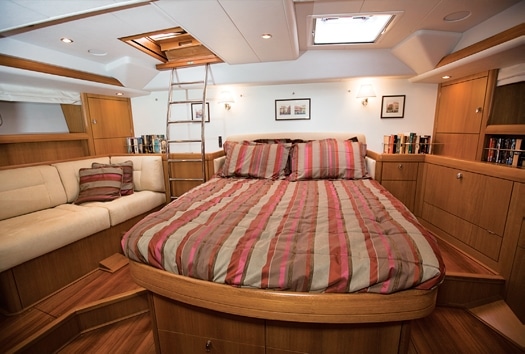
| | |
There are eight berths in four cabins, including a large aft master stateroom. On the starboard side is a long settee, which doubles as a decent sea berth. There is a desk, hanging locker, and drawers everywhere, including four large drawers under the berth. I was delighted to see plenty of bookcases, which are indispensable, in my opinion, to a cruising boat. I also found a hidden combination-washer-anddryer unit. An aft hatch and ladder to the cockpit area lets the owner slide up on deck to see what’s going on or exit for a morning swim.
Access to the engine area is convenient and bright with plenty of space to work. A 185-horsepower Perkins Sabre 6-cylinder turbocharged diesel is coupled to a feathering Max-Prop 3 blade.
With the proper layout, amenities, and stowage, I could easily spend a month or longer on Matchmaker and I began to wonder how I could arrange the time to work while on an extended sail. The majority of that time would clearly be spent on deck. The cockpit area is huge! The five of us sat around in kind of a trance, perhaps wondering about ports beyond the Chesapeake Bay. We were under full sail, and heeling at about 15 degrees. Upwind, the speedometer read 8 knots. When I bore off on a close reach we were sailing at 9.5. The helm is a joy. I could stay there all day. The big rig gave the boat plenty of power and during our sail we were never close to needing a reef.
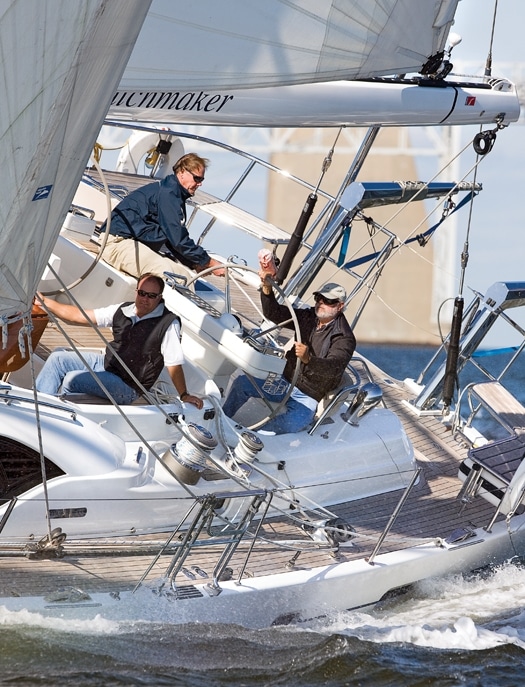
| | |
During tacks, we rolled the jib up halfway so it would easily get around the inner forestay. On the afterdeck there were two seats. Each was big enough for two people to sit, talk and enjoy the ride. It was a serene perch, providing Lloyd and I the chance to discuss his boat in more detail. I asked him why he bought the Oyster 655. “It started with the cockpit table of my former 55-foot boat. We needed a bigger table for drinking and relaxing,” he said. “That is what got my wife interested in the idea of a bigger boat. Next was the fact that it would be faster to sail.”
At the helm, I had a good line of sight in all directions, thanks to the double wheels. The Oyster 655 is fast! I couldn’t help but notice how people watched and waved as we sailed past. “Steering her is a dream. It’s safe, predictable, just solid and very trustworthy,” Lloyd remarked. The deep rudder turns the boat easily. There was no play in the steering system. With a full head of steam, I bore away from the wind without easing the sails to see if the boat would stall-it did not. But we did heel over a few more degrees, as you would expect. Going through a tack is a purposeful maneuver on this 82,673-pound Oyster.
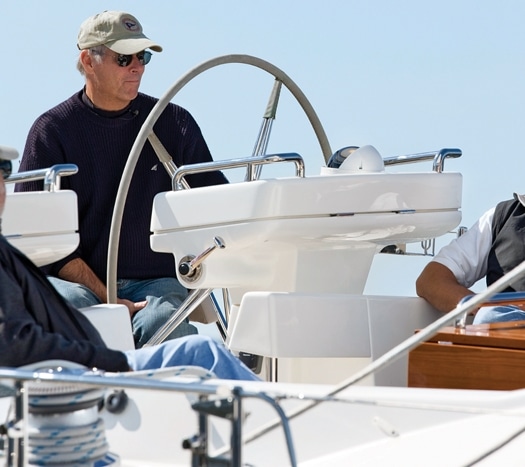
| | |
I didn’t get to sail her in winds of less than 8 knots, so I can’t report on the 655’s light-wind performance. The sail plan is substantial, with a 150-percent foretriangle (2,830 square feet of sail area).
Located on both sides of the aft quarter are large seats that fit at least two full-size adults. I could sit here for hours, watching the waves, the passing sights, reading, or simply daydreaming about our next port.
Two Oyster representatives were on board for the sail-Bob Marston and Will White. Marston, who is based in Newport, Rhode Island, explained the company’s philosophy. “These boats are built with the customer in mind. They are really meant for long-distance sailing and liveaboard cruising. We built them for people to get out there and use them.”
My friend David spent a good deal of time at the wheel. On the way into the harbor I asked him for his impressions. “I think the boat is really wonderful to sail. It’s substantial and built well,” he said. “I’d love to spend a month cruising on her.” That seems to be the consensus from everyone who steps aboard the 655 and when we returned to the crowded Annapolis harbor, we were all smiling after a fantastic day of sailing.
The Oyster 655 is a solid boat that wants to ply blue water. In fact, back at the dock, I wondered how I could get an invite from Lloyd for the winter season in the Caribbean.
Oyster Marine, (401) 846-7400; **www.oystermarine.com**









